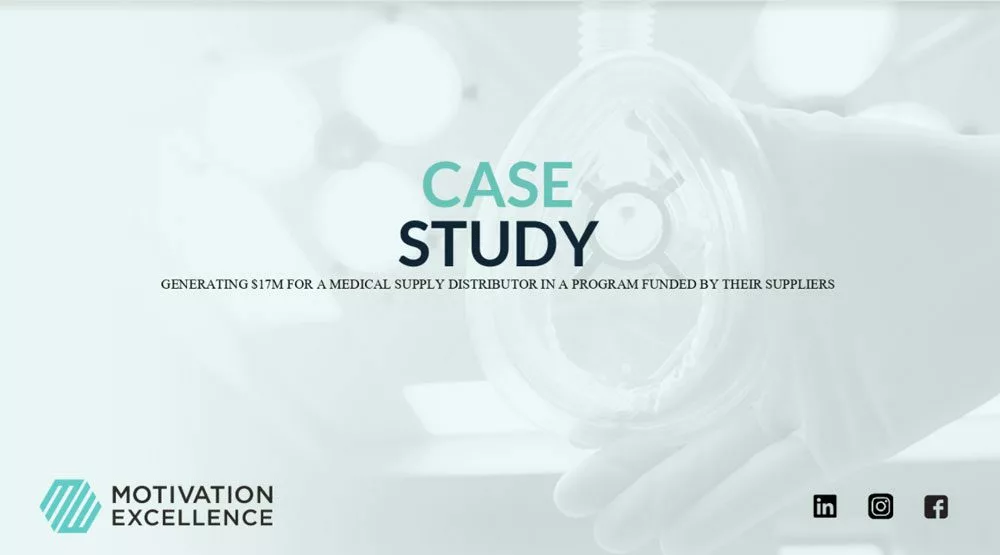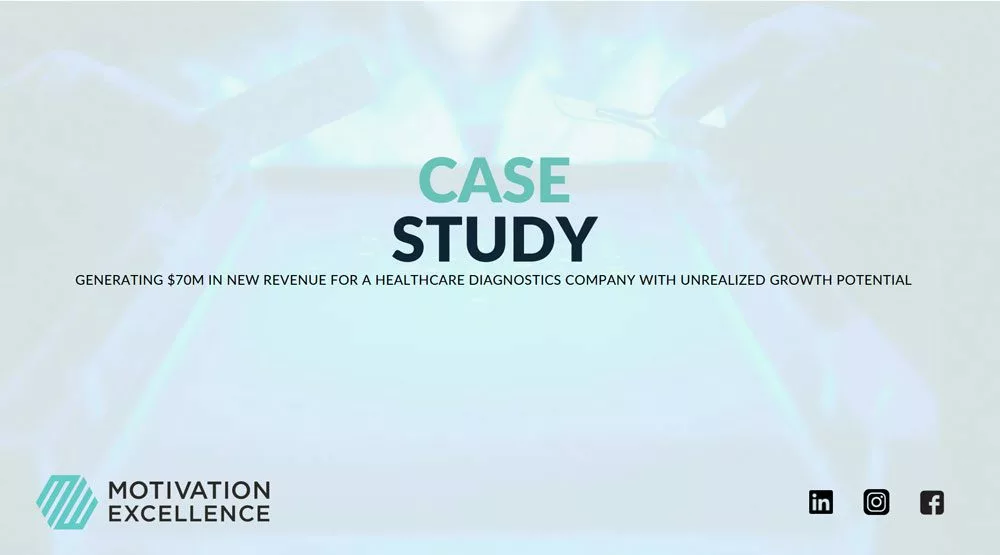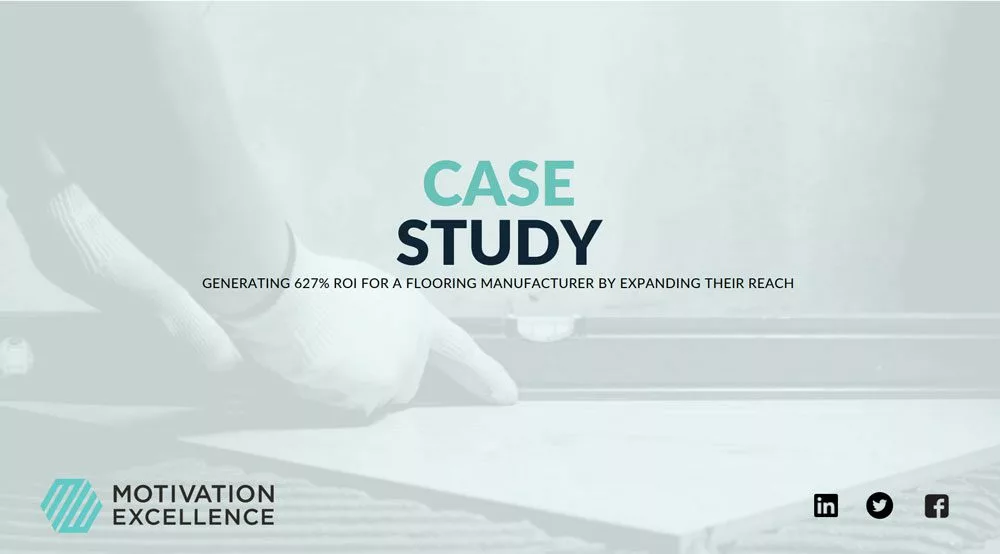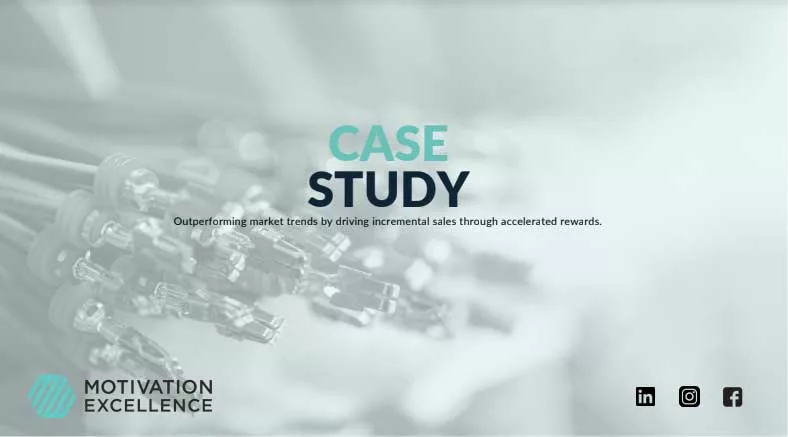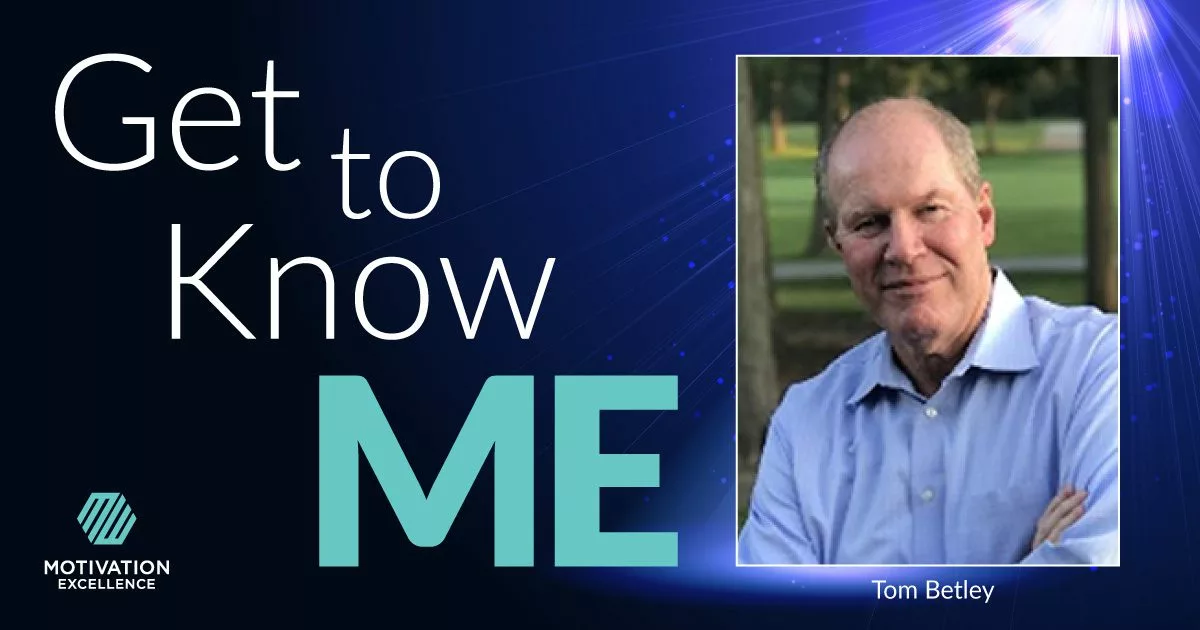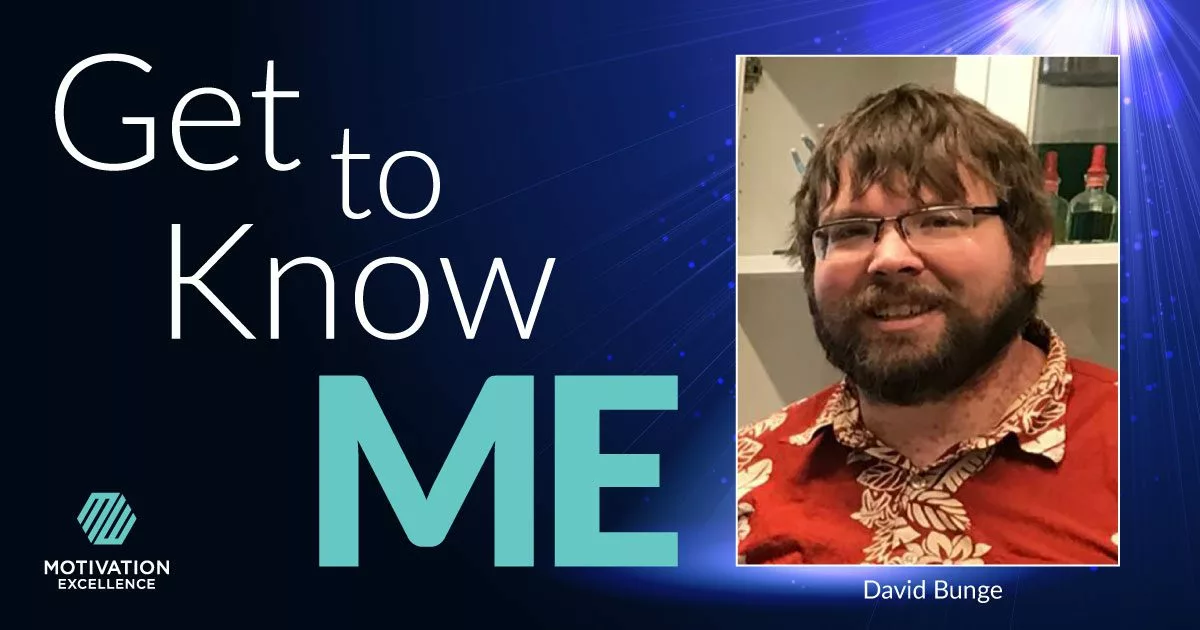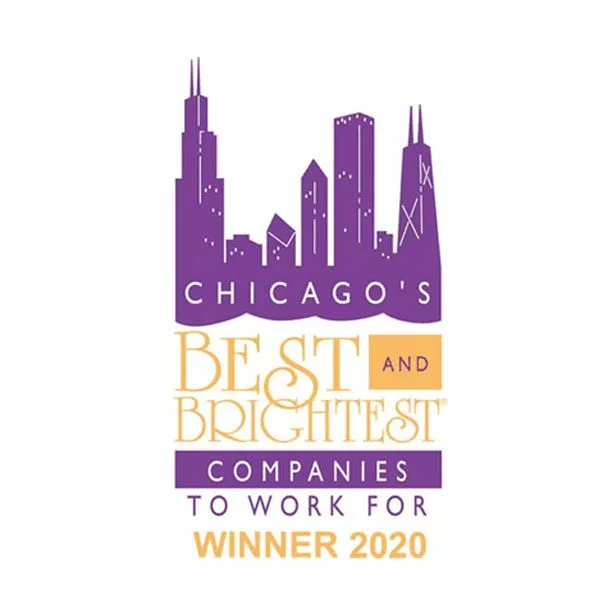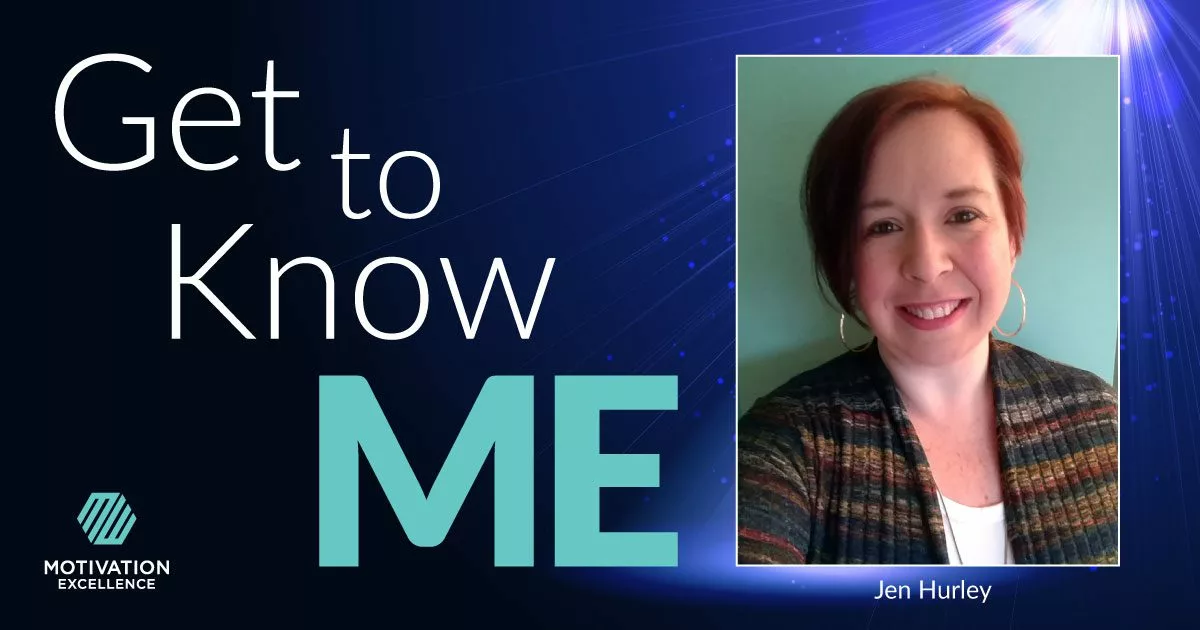Medical Supply Distributor
GENERATING $17M FOR A MEDICAL SUPPLY DISTRIBUTOR IN A PROGRAM FUNDED BY THEIR SUPPLIERS
The Big Picture
Our Medical Supply Distribution client wanted to drive sales with a dynamic incentive for their preferred, non-competitive suppliers that would be completely funded by their sales efforts. The suppliers — 6-10 participated in various years — were initially reluctant to participate due to a lack of confidence in their return on their investment. We knew we needed to overcome their skepticism.
Research & Analysis
A thoughtful and fair ROI rule structure and tracking system was needed. In the initial analysis stage, we examined the previous two years of sales by rep, and then set individual growth goals for each of the six suppliers.
Our Solution
We created an incremental growth program for each supplier so that together, they would fund the program on our sponsoring client’s behalf.
After we created incremental goals by supplier, we set up a system to provide reporting so they could clearly see the growth being generated. This solved the funding issue that initially made the distributors reluctant to participate; They were happy to fund the program when they could easily see the growth it was fostering.
Since the client’s existing system did not communicate in silos, we sought to isolate communications specific to each supplier and connect directly with the sales reps that sell those products.
This program was points-driven. We set goals for each supplier and assigned point values to those goals. Each sales rep was able to use our online portal to view their performance and their status at any time.
Quantifiable Results
ROI
Participating suppliers increased sales by 11.75% over plan.
Volume was up more than $17M for selected suppliers.
Equity
At program end, participants were awarded their points as a one-time payout and were able to redeem for name-brand merchandise, travel options or experiences from our expansive online catalog.
Data & Analytics
Getting 6-10 different suppliers to work together in an equitable arrangement is the kind of data-driven, personalized work that sets Motivation Excellence apart.

Health Care Diagnostic
Generating $70M in new revenue for a healthcare diagnostic company with unrealized growth potential
The Big Picture
Our Healthcare Diagnostics client wanted to enhance their bottom line by identifying new locations and expansion opportunities, enhancing customer service, and expanding their product portfolio. They came to Motivation Excellence to find out how they could turbocharge these efforts.
Research & Analysis
During our analysis, we realized our client had little knowledge of their opportunity potential. We discovered that their delivery and pickup drivers were everywhere, making valuable connections with current and potential customers on a regular basis. Through these relationships, the drivers were in a position to discover expansion opportunities as well as customer service issues needing resolution. This valuable information could be transferred to their sales reps and converted to leads, but at that time, no one had conceived of the two departments working together, and the infrastructure was not in place to do so.
Our Solution
Once we uncovered this critical gap between drivers and sales reps, we designed an incentive program targeted to getting them working together address the client’s challenges. While the two groups were highly skeptical that their partnership would yield results, they soon found common ground and began to generate amazing results.
First, we developed a custom lead generation system that linked drivers to specific sales reps for lead generation and management. To foster compliance, we had to accommodate the drivers’ preference for paper and the sales reps’ preference for digital.
Next, we trained both groups to generate information and act upon leads, and then to record their efforts. We thus captured metrics on the number of leads, type of lead, disposition time, and outcome.
We ultimately brought together stakeholders from both sales and delivery silos within the organization, when neither side believed at the beginning that their partnership would be fruitful.[/et_pb_text]
Design Details
This program continues to generate revenue after more than nine years in operation, fulfilling the client’s desires to expand and optimize their services while fostering a team environment in their organization
Custom Platform: An end-to-end lead generation tracking system designed to drive ROI for behavior change as well as revenue.
Marketing Campaign: Helping the executive stakeholders explain the benefits of the program and encourage participation.
Communications: To keep everyone abreast of standings, motivated and focused. Sharing partership success stories was key to fostering participation.
Points-Based System: Sales reps earned points redeemable from our online catalog of brand-name merchandise and experiences
Gift Cards: Drivers, who skewed older and were far less likely to use smartphones or engage with the online catalog, earned gift cards.
Monitoring: With a three-month lead-to-sales cycle, we tracked KPI & ROI to keep our client in the loop
Quantifiable Results


Flooring Company
Generating 627% ROI for a flooring manufacturer by expanding their reach
Our Flooring Manufacturing client wanted to motivate commercial flooring contractors and internal sales reps to higher performance with a self-funding program. But after examining their goals and program projections, we told them they simply could not reach their goals without expanding their audience significantly.
Our Solution
Using industry specific data, we built a custom solution focused on our understanding of the participants.
Step 1: We expanded the audience for this incentive to be 3½ times greater than the client originally planned for —1,200 commercial contractors and internal sales reps — to ensure the client would meet their aggressive revenue goal.
Step 2: We leveraged our communications expertise to acquire the audience and maintain their engagement throughout the program earnings period.
Step 3: We aligned the desired behaviors with meaningful rewards that both top performers and middle performers would view as attainable.
Design Details
The program was designed to be fully funded by incremental gross profits. We exceeded ROI estimates with these elements:
Consultation: We had the experience to know the client’s program was not going to work, and the expertise to know just how to fix it
Marketing Campaign: The aggressive, highly targeted audience acquisition plan included program announcement, teaser postcards, and invitations to register.
Communications: To keep everyone abreast of standings, motivated and focused. A program portal drove participant engagement throughout the program.
Points-Based System: Goals were set and points were redeemed from our online catalog for merchandise, gift cards and individual travel.
Desirable Rewards: Top performers (based on highest sales, greatest $$ increase and greatest % increase), earned a coveted travel award for two hosted by the client’s executive team.
Monitoring: We tracked KPI & ROI to keep our client in the loop.


Electrical Supply
Outperforming market trends by driving incremental sales through accelerated rewards.
The Big Picture
Coming out of a sluggish economy more than 30 years ago, a nationally ranked electrical distributor wanted significant growth and brand recognition within the industry. After analyzing their business, as well as industry benchmarks and sales data, we collaborated to develop a program structure to drive incremental sales through accelerating reward opportunities to keep customers engaged. This program started pre-internet and evolved into a digital era over a 20 year timespan.
Our Solution
Using industry specific data, we built a custom solution focused on our understanding of the participants.
We segmented their 100,000-customer audience into three groups and then assigned the top 20% individual growth goals based on their segment and past purchases. We kicked off the program with a fast start sweepstakes to engage customers quickly.
Using projected sales growth, our client secured vendor funding to help pay for the program. With the evergreen program structure, participants created a sustained growth pattern year over year.
Individual branch locations received regular program communications and activity reports. Those purchasing over goal had accelerated reward opportunities. we offered a wide variety of award redemption options to keep top performers engaged in the outcome each year. including multiple travel programs and an option to buy-in.
Design Details
Over a span of more than a decade, revenue growth for enrolled customers outperformed non-enrolled and industrytrends in up, flat and down markets. ROI was more than 200% and our client realized significant market share growth. Extraordinary vendor participation substantially paid for program costs and those vendors also increased their own customer count.

Measurable Results
By creating an evergreen program that continued year after year, we were able to establish a base line purchase level for each customer and then assign a growth goal each year afterward. This created sustained growth over the life of the program for each customer wanting to achieve the top tier travel award each time it was offered.


Agricultural Manufacturer
How we generated $64M in gross profit for an agricultural manufacturer – and one heifer
The Big Picture
It started with an incentive program we presented to an agriculture manufacturing client to enhance sales for a specific product. They thought it was such a great idea, they wanted to apply it across all 12 of their product lines. No less than 16 vendors were brought in to present their solutions over a 6-week evaluation period. They said they chose Motivation Excellence because we knew their industry and understood their challenges and opportunities. The biggest challenge here was the lack of data tracking where products were being sold, and by which sales reps.

Research & Analysis
We took a measured approach to mitigate risk. We first conducted field research to better understand our participants, the products they sell, where their products were being sold, their industry outlook, and what moves them. We also analyzed how best to capture the sales rep sales data needed to focus our efforts.
Our Solution
Our industry research, experience, and analysis led us to a custom, multi-year performance improvement solution
- In Year 1, we built rep-level tracking, identified participants, and captured baseline sales data by implementing a custom platform we designed to integrate with the client’s warranty system. Understanding where certain products were most likely to be sold was critical to designing the programs.
- In Year 2, we launched the incentive program for dealer sales reps across all the client’s product lines. Armed with sales data, we set realistic regional and product line-specific dealer goals, fostered engagement, loyalty, and teamwork within the channel, and drove growth and ROI with tiered incentive rewards and a great shopping experience.
- In Year 3, we realized the opportunity to sell the replacement parts needed across a range of products and created a cohesive program for all the client’s customers. We took regional priorities and product group-specific needs into consideration to develop a seamless program for the client’s channel.
Design Details
Understanding the challenges, our sophisticated, ROI-centered plan addresses all our client’s concerns. These elements made it work:
Custom Platform
Integrated with our client’s warranty tracking system, our platform tracked sales to the rep level without adding a learning curve for participants.
Marketing Campaign
Focused on the dealer owner to explain the benefits of the program and encourage them to enroll the sales reps.
Communications
To keep everyone informed on their standings, motivated, and focused on top awards.
Points-Based System
Earned on equipment and financing products. When the dealership reached its goal, everyone earned bonus points.
Motivating Rewards
Including a prestigious travel experience for top-performing sales reps, and award points redeemable for individual travel, event ticket, and specialty items.
Monitoring
Tracking KPI & ROI quarterly to keep our client in the loop.
Only at Motivation Excellence
When it comes to service, we go the extra mile, for clients and their participants alike. When one of this program’s participants called our personal shopper, Susan, to see if there was a way to redeem his points for a heifer for his granddaughter’s 4H Club, we didn’t flinch. Instead, Susan got to work. And the participant got himself a fine-looking heifer.
Proof positive that at Motivation Excellence, we’re big enough to serve…but small enough to care.

Quantifiable Results
ROI
ROI exceeded goal by by 27.3%, generating $64.4M net GP over goal.
Equity
We built equity with dealers and their sales reps through program communications, attainable and desirable rewards, and a great reward experience.
Data & Analytics
With the tracking systems we put in place, we were able to gather critical sales data and create analytics to help our clients see their sales and ROI opportunities more clearly.

Get to Know ME with Tom Betley
Tom Betley is our East Coast Director of Business Development, based in the New Jersey/Philly area. He has many passions and loves to chat about sports, travel and family the most! He’s quick with a joke and loves to razz his coworkers whenever he can. Read below for more insights and be sure to watch Tom’s Get to Know ME video embedded too!
What’s your title and how long have you been at Motivation Excellence?
Director of Business Development – two stints totaling 15 years.
What does your job entail?
Calling on existing clients and prospecting for new clients. Helping each of them address specific business issues that call for a behavior change to impact performance.
What’s something special about working at Motivation Excellence that you’d like to share?
From the owner down through the organization we all work together in a customer-first way to ensure creative solutions based offerings but exceed expectations delivery.
What’s your favorite part of your job at Motivation Excellence?
We have an exercise called “where in the world” that we go through when we have a new or existing client and we are making suggestions on a travel experience. We usually do it over a cigar and try to match a destination with the demographics, budget and preferences of the client. FUN!
What’s an unknown or odd talent you have?
I make 9 out of 10 foul shots with my eyes closed. Still to this day.
What motivates you to accomplish things in your life (work or personal)?
Competing. I love competition whether at golf, a board game, work achievement, or an NCAA pool.
What do you enjoy doing outside work?
Travel, golf, spend time at our campsite, spend time with our kids and grandkids.
One thing that always makes you laugh is?
Rodney Dangerfield
What have you done that helped you get through the pandemic?
Lots of stuff around the house with my wife leading the charge. Stuff I used to address by saying “I gotta a guy that can do that”, I am now doing myself.
What is the most unusual job you’ve ever had?
Machine shop in HS. We drilled holes in metal that would eventually become heart machines. Can you spell BORING!
This month, our theme for social media is self-awareness. How do you apply self-awareness principles to your life? (you can read my blog to get info on self-awareness)
I guess the biggest change I’ve made regarding self-awareness is not reacting emotionally to something I hear or see. I am definitely more aware of listening and not reacting right away. I think my daily cigar is one of the great ways to take time to reflect.
Get to Know ME with Dave Bunge
Dave Bunge is celebrating an anniversary with Motivation Excellence this month! Read below and watch the video to learn some fun facts about our game-loving web developer. Anyone else out there broken the same bone multiple times? We’re glad you’re all healed now, Dave!
What’s your title and how long have you been at Motivation Excellence?
Web Developer/Programmer, 7 years (as of 12/12/2020)
What does your job entail?
I support clients by building websites to support the programs that we run for them.
What’s your favorite part of your job at Motivation Excellence?
Relationships with coworkers.
What motivates you to accomplish things in your life (work or personal)?
Feeling a sense of accomplishment and pride.
What do you enjoy doing outside work?
I play various games on my PC and watch videos on Amazon Prime & Disney+.
One thing that always makes you laugh is?
Watching videos of my niece and nephews and hearing their cute laughs.
What have you done that’s helped you get through 2020?
Some of my normal weekly activities went digital through Zoom and Discord, so I’ve been able to keep in touch with people. I also joined a new Meetup group for D&D Newbies and played some one-shots with strangers.
What is the most unusual job you’ve ever had?
I don’t consider any of my jobs to be unusual. I worked at Hollywood Video in high school for a while, and I worked at Culver’s. Apart from that, I’ve been working as a web developer, which I do not consider unusual.
Get to Know ME with Tina Roszak
We’re happy to give you a little inside peek at one of our Travel Program Managers, Tina Roszak! It’s teammates like Tina who make working at Motivation Excellence a happier place. Just don’t let her get you in her “sights” apparently. LOL.
What’s your title and how long have you been at Motivation Excellence?
Travel Program Manager. In January, it will be 17 years that I’ve been with MEI.
What’s something special about working at Motivation Excellence that you’d like to share?
The people! We care about each other and always work together as a tight-knit team.
What’s your favorite part of your job at Motivation Excellence?
(Creating) the menus and décor elements of a program.
What’s an unknown or odd talent you have?
I’m pretty good at target shooting.
What motivates you to accomplish things in your life (work or personal)?
Optimism that each day is a new start for a brighter tomorrow. Wanting to be a positive influence in the world around me.
What do you enjoy doing outside work?
Gardening, coloring and exploring nature
One thing that always makes you laugh is?
My husband! He always knows how to make me laugh, even after 30 years!
What have you done that’s helped you get through 2020?
Realizing my blessings and being grateful for the loving people around me.
Motivation Excellence Celebrates Back to Back Honors
It’s with great pleasure we announce being honored with the Best and Brightest Companies to work for® in the Nation distinction again in 2020! Motivation Excellence is one of 147 national winners among 1,300 applicants. We hold 2019 honors for this national category, as well as for Companies in Chicago for 2019 and 2020.
The Best and the Brightest Companies to Work For® celebrates achievement and success in empowering employees’ lives through rich heritage and culture. Its mission is “Better Business, Richer Lives, Stronger Communities.” Each winning company has demonstrated a positive impact on its employees resulting in happier and more productive work environments.
“It’s a long, all-encompassing application process that includes an anonymous survey for each of our employees to fill out. Even though it takes a lot of time to apply each year, I’m thrilled with the results! It’s great to have the outside world see Motivation Excellence the way we all see it: A wonderful place to work and thrive!” says Diane Kelly, VP Finance & Admin, who takes on the task to apply each year.
Motivation Excellence recently premiered its new corporate headquarters.
This new space was designed to embody its mission to Inspire Extraordinary Performance. The office is filled with a lot of bright color, natural light and collaborative work areas. Materials used, from the carpeting to the furniture, are eco-friendly. Due to COVID-19, employees are splitting their time between the new office and remote working.



“I can’t wait for the day that we can be at full capacity in our new headquarters, but having the flexibility for each person here to be able to work from home is a real blessing. During COVID-19 this spring when everyone was remote, our events committee worked hard to continue to engage our team with activities like virtual meeting bingo, meet my furry coworker pictures and Friday happy hours. That we all remained connected during a stressful time points to the positive culture we’ve carefully nourished at Motivation Excellence with the guidance of our senior leadership, Bob Graham, Brad Hecht, Diane Kelly and Rhonda Brewer,” says David Jobes, Owner and President.
Besides flexible working arrangements, other perks of working at Motivation Excellence include receiving two days off each year to help a favorite charity and a work anniversary holiday. Employees often comment how they see their coworkers as part of a family. Almost a third of our nearly 30 employees have been with Motivation Excellence for more than 20 years!
This is the 10th Annual Best and Brightest Companies to Work For® award announcement.
Get to Know ME with Jen Hurley
There are some people who just have a knack for numbers! Jen Hurley is one of those people who happens to work in our accounting department – how fortunate for us! Read and watch Jen tell us some inside info on the joys she has at Motivation Excellence and at home.
What’s your title and how long have you been at Motivation Excellence?
My title is Project Accountant, and I’ve been with Motivation Excellence for 6 ½ years.
What’s something special about working at Motivation Excellence that you’d like to share?
One thing that makes Motivation Excellence stand out is the unwavering support I have received. In the 6+ years I have been here I have been through more ‘situations’ than most people go through in a decade. Through it all, everyone at Motivation Excellence, from my co-workers to management, has supported and encouraged me.
What’s your favorite task as an accountant for Motivation Excellence?
There are so many favorite tasks! I’m always up for a good puzzle so reconciling accounts or programs is always fun.
What’s an unknown or odd talent you have?
I have an uncanny knack for remembering useless information and used to do bar trivia every week with friends.
What motivates you to accomplish things in your life (work or personal)?
I always want to make a difference. Knowing that I can have a positive impact on someone else’s day, be it my husband, kids, co-workers or a stranger, helps give me that extra boost to get things done.
What do you enjoy doing outside work?
I’m an avid reader, I enjoy surfing around Pinterest and creating (and often failing) projects and spending time with my family.
One thing that always makes you laugh is?
I have an odd sense of humor and often laugh at inappropriate times. Once I get going, it is really hard to get it under control. My kids make me laugh every day without fail.
What’s the most interesting former job you’ve had?
I’ve always worked in accounting, so every job I’ve had has been interesting! No, really! But, if you need an example, my first job was as a billing clerk for the trucking company that shipped Tootsie Rolls for Knights of Columbus fundraisers and Terri Lynn peanuts for Kiwanis fundraisers. So, if you ever donated a buck to the guy in the intersection in the 90’s and got a Tootsie Roll or bag of peanuts in return, odds are I had something to do with it.
